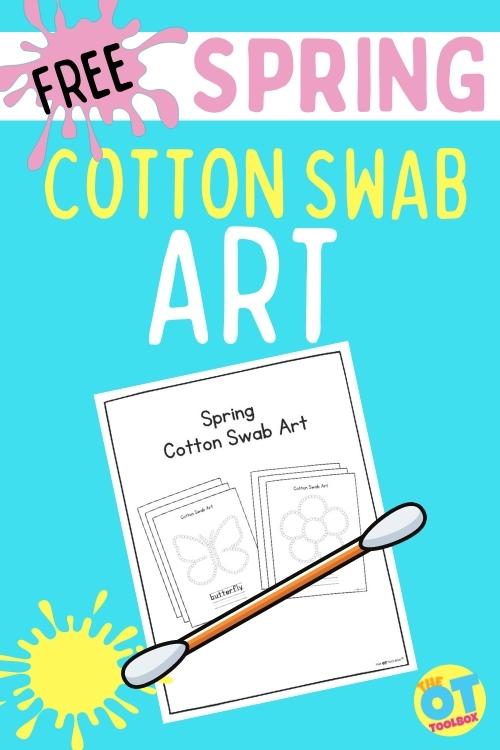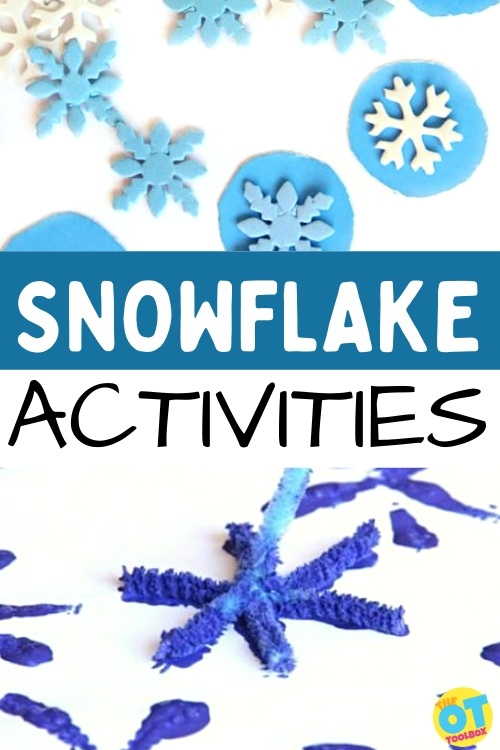There are signs of Spring everywhere, and this Spring Cotton Swab Painting is one of them! This spring themed Cotton Swab Painting activity will get you in the mood to change things up a bit, while developing important skills. This is a powerhouse Spring occupational therapy activity that builds many developmental areas through art. Add this idea to our list of creative art ideas for sensory painting!
Using cotton swabs to paint is a creative painting strategy that builds more than just fine motor skills…read on!

Cotton swab painting
Before diving deep into the why and how of cotton swab painting, let’s talk about cotton swabs (formerly known as Q-Tips) first:
- They are great disposable tools to use when germs are a concern
- Your learner is only going to gag themselves once with it, before learning a valuable lesson
- If you learner is sticking it in their nose, eye, or anywhere else it does not belong, they need extra supervision
- Sustainability a concern? Last Swab makes (Amazon affiliate link) REUSABLE cotton swabs! Check it out! In the FAQ it says these are appropriate for art projects
- Cotton swabs come in different colors, sizes, shapes, varieties for pure enjoyment purposes, or to develop different skills
Cotton Swab Art and Fine Motor
In doing research on the connection between math and fine motor skills, the data suggests fine motor precision is just as important as visual motor skills.
Being able to cut on a line is not enough. An advanced learner needs to be able to cut intricate shapes. Science, technology, engineering, and math (STEM) learning is at the forefront of education.
These specific subjects require fine motor skills beyond basic cutting, writing, and coloring. This post on Using Everyday Items to Build a Tripod Grasp is helpful and informative.
The Spring cotton swab painting worksheet available at the bottom of this blog post develops fine motor skills while honing in on precision.
Not only do learners need to develop command over the cotton swab, they need to be able to precisely mark it into the correct circular space. This does not rule out less advanced learners.
There is much to be gained from this task, without being able to make the dots in the correct places.
There are too many skills to count that are developed using just this one task.
The benefits of cotton swab art in therapy to develop skills include:
- Kinesthetic awareness – This means learning by doing. What better way to practice fine motor precision than with cotton swab painting!
- Hand strength and dexterity – Dotting within the borders builds hand muscles and develops muscle control.
- Visual motor skills –combining what is seen visually and what is produced motorically. This takes coordination to be able to translate information from visual input to motor output. Being able to dot onto a designated spot is more than just making random marks on paper.
- Visual Perception – scanning to find all the dots, and visual closure to understand that dotted lines will create something.
- Sequencing – will your learner do the dots in order? Will they go in a haphazard pattern all over the page? There really isn’t a right way in this task, but learning sequencing will be important in higher level tasks such as math
- Proprioception – pressure on paper, grip on cotton swab
- Social/Executive Function – Following directions, turn taking, task completion, orienting to details, neatness, multi-tasking, attending to task, compliance, task completion, and impulse control can be addressed using this Spring Cotton Swab Painting PDF
- Bilateral coordination – remembering to use their “helper hand” to hold the paper while painting. Using one hand for a dominant hand instead of switching back and forth is encouraged once a child is in grade school or demonstrates a significant strength in one or the other.
- Strength – core strength, shoulder and wrist stability, head control, balance, and hand strength are all needed for upright sitting posture and fine motor tasks.
Remember, you can address all of these skills at once, or focus on one or two. Some skills above will be addressed without your conscious knowledge, while other skills will be directly worked on.
Using a cotton swab art activity for different levels
It is definitely possible to use a cotton swab art activity for various levels and skills. One single activity can be used with a whole therapy caseload, while meeting different skills, needs, and developmental levels.
How do I grade (make it easier/harder), change, or modify this task? There are a million ways to use this cotton swab art in your treatment plans. Below are just a few ideas to get you started:
- Make this part of a larger lesson plan including gross motor, sensory, social, executive function, or other fine motor skills
- Print in black and white or color for different levels of difficulty
- Print on colored paper and use a hole punch to create this design
- Talk about spring, clouds, flowers, seasons and more to further engage your learners
- Enlarging the font may be necessary to beginning learners who need bigger space due to less accuracy
- Vary the level of prompting to grade the activity to make it easier or harder.
- Add a sensory element by using a finger tip instead of a cotton bud.
- Use different types of paint or shaving cream for alternate types of learning
- Work in pairs or in a small group to address problem solving, turn taking, and negotiation skills.
- Make baked cotton swabs to work on developing fine motor skills. I wonder if these can be used as watercolor paints? This would eliminate some of the mess
- Add glitter! Glitter makes everything wonderful
The OT Toolbox has some great ideas for spring themes, fine motor precision, arts and crafts, treatment planning and more. Start with this spring flower eye hand coordination activity. What about more cotton swab activities? Since you can buy these cotton buds in packs of thousands, you might as well use them in more than one activity.
Feeling overwhelmed? Starting something new can feel intimidating. Some people are able to plow through their apprehension, while others get stuck. Either way, the OT Toolbox has just what you need.
An entire kit of Spring Fine Motor Activities! This print-and-go Spring fine motor kit includes no-prep fine motor activities to help kids develop functional grasp, dexterity, strength, and endurance. Use fun, Spring-themed, fine motor activities so you can help children develop strong fine motor skills in a digital world.
What does spring mean to you? Embrace the new season and take a risk. Get out of your comfort zone and push your learners to get out of theirs.
Free Cotton Swab Art Worksheets
Want to add this resource to your therapy toolbox so you can help kids thrive? Enter your email into the form below to access this printable tool.
This resource is just one of the many tools available in The OT Toolbox Member’s Club. Each month, members get instant access to downloadable activities, handouts, worksheets, and printable tools to support development. Members can log into their dashboard and access all of our free downloads in one place. Plus, you’ll find exclusive materials and premium level materials.
Level 1 members gain instant access to all of the downloads available on the site, without enter your email each time PLUS exclusive new resources each month.
Level 2 members get access to all of our downloads, exclusive new resources each month, PLUS additional, premium content each month: therapy kits, screening tools, games, therapy packets, and much more. AND, level 2 members get ad-free content across the entire OT Toolbox website.
Join the Member’s Club today!
NOTE*The term, “learner” is used throughout this post for consistency. This information is relevant for students, patients, clients, preschoolers, kids/children of all ages and stages or whomever could benefit from these resources. The term “they” is used instead of he/she to be inclusive.

Victoria Wood, OTR/L is a contributor to The OT Toolbox and has been providing Occupational Therapy treatment in pediatrics for more than 25 years. She has practiced in hospital settings (inpatient, outpatient, NICU, PICU), school systems, and outpatient clinics in several states. She has treated hundreds of children with various sensory processing dysfunction in the areas of behavior, gross/fine motor skills, social skills and self-care. Ms. Wood has also been a featured speaker at seminars, webinars, and school staff development training. She is the author of Seeing your Home and Community with Sensory Eyes.




